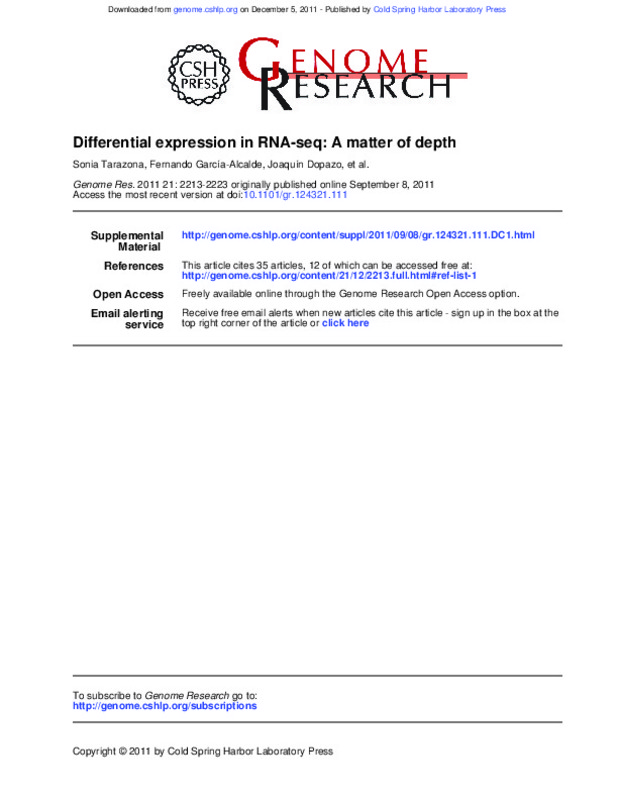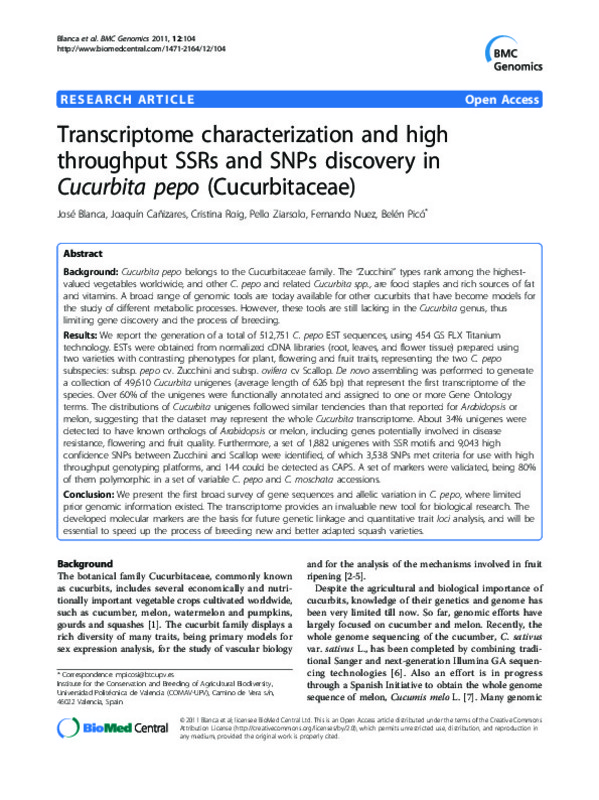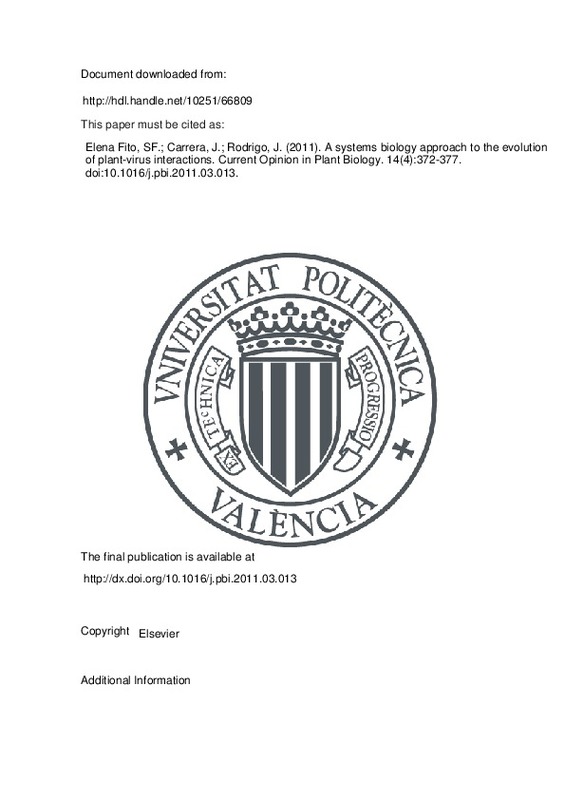Tarazona Campos, S.; García-Alcalde, F.; Dopazo, J.; Ferrer Riquelme, AJ.; Conesa, A. (2011). Differential expression in RNA-seq: A matter of depth. Genome Research. 21(12):2213-2223. doi:10.1101/gr.124321.111
Por favor, use este identificador para citar o enlazar este ítem: http://hdl.handle.net/10251/28113
|
Título:
|
Differential expression in RNA-seq: A matter of depth
|
|
Autor:
|

 Tarazona Campos, Sonia
García-Alcalde, Fernando
Dopazo, Joaquín
Tarazona Campos, Sonia
García-Alcalde, Fernando
Dopazo, Joaquín

 Ferrer Riquelme, Alberto José
Conesa, Ana
Ferrer Riquelme, Alberto José
Conesa, Ana
|
|
Entidad UPV:
|
Universitat Politècnica de València. Departamento de Estadística e Investigación Operativa Aplicadas y Calidad - Departament d'Estadística i Investigació Operativa Aplicades i Qualitat
|
|
Fecha difusión:
|
|
|
Resumen:
|
Next-generation sequencing (NGS) technologies are revolutionizing genome research, and in particular, their application to transcriptomics (RNA-seq) is increasingly being used for gene expression profiling as a replacement ...[+]
Next-generation sequencing (NGS) technologies are revolutionizing genome research, and in particular, their application to transcriptomics (RNA-seq) is increasingly being used for gene expression profiling as a replacement for microarrays. However, the properties of RNA-seq data have not been yet fully established, and additional research is needed for understanding how these data respond to differential expression analysis. In this work, we set out to gain insights into the characteristics of RNA-seq data analysis by studying an important parameter of this technology: the sequencing depth. We have analyzed how sequencing depth affects the detection of transcripts and their identification as differentially expressed, looking at aspects such as transcript biotype, length, expression level, and fold-change. We have evaluated different algorithms available for the analysis of RNA-seq and proposed a novel approach-NOISeq-that differs from existing methods in that it is data-adaptive and nonparametric. Our results reveal that most existing methodologies suffer from a strong dependency on sequencing depth for their differential expression calls and that this results in a considerable number of false positives that increases as the number of reads grows. In contrast, our proposed method models the noise distribution from the actual data, can therefore better adapt to the size of the data set, and is more effective in controlling the rate of false discoveries. This work discusses the true potential of RNA-seq for studying regulation at low expression ranges, the noise within RNA-seq data, and the issue of replication. © 2011 by Cold Spring Harbor Laboratory Press.
[-]
|
|
Palabras clave:
|
Algorithm
,
Article
,
Biotype
,
Data analysis software
,
Gene expression
,
Gene identification
,
Genetic transcription
,
Human
,
Methodology
,
Priority journal
,
RNA sequence
,
Signal noise ratio
,
Transcriptomics
,
Algorithms
,
Expressed Sequence Tags
,
Gene Expression Profiling
,
Gene Expression Regulation
,
Humans
,
Models, Genetic
,
Oligonucleotide Array Sequence Analysis
|
|
Derechos de uso:
|
Reserva de todos los derechos
|
|
Fuente:
|
Genome Research. (issn:
1088-9051
)
|
|
DOI:
|
10.1101/gr.124321.111
|
|
Editorial:
|
Cold Spring Harbor Laboratory Press
|
|
Versión del editor:
|
http://genome.cshlp.org/content/21/12/2213.full.pdf+html
|
|
Código del Proyecto:
|
info:eu-repo/grantAgreement/MICINN//BIO2008-05266-E/ES/PATHOGENOMICS - METABOLOMICA E INTERACTOMICA DE LA RELACION HUESPED-PATOGENO/
info:eu-repo/grantAgreement/MICINN//BIO2008-04638-E/ES/PATHOGENOMICS - REDES TRANSCRIPCIONALES CONTROLADORAS DE VIRULENCIA EN HONGOS FILAMENTOSOS PATOGENOS/
info:eu-repo/grantAgreement/MICINN//BIO2009-10799/ES/Estudio De Nuevas Relaciones Genoma-Transcriptoma Mediante Tecnicas De Ultrasecuenciacion/
info:eu-repo/grantAgreement/MICINN//BIO2008-04212/ES/RELACION ENTRE LA ARQUITECTURA CROMOSOMICA, LA FUNCION GENICA Y SU IMPLICACION EN PATOLOGIAS/
info:eu-repo/grantAgreement/GV//PROMETEO%2F2010%2F001
|
|
Agradecimientos:
|
This research was supported by grants BIO2008-05266-E and BIO2008-04638-E from the Spanish Ministry of Science and Innovation (MICINN), in the framework of ERA-Net Pathogenomics, and grants BIO2009-10799 from the MICINN; ...[+]
This research was supported by grants BIO2008-05266-E and BIO2008-04638-E from the Spanish Ministry of Science and Innovation (MICINN), in the framework of ERA-Net Pathogenomics, and grants BIO2009-10799 from the MICINN; BIO2008-04212 from the MICINN, and PROMETEO/2010/001 from the GVA-FEDER. We also acknowledge the support of the National Institute of Bioinformatics (www.inab.org) and the CIBER de Enfermedades Raras, both initiatives of the ISCIII, MICINN. This work is also partly supported by a grant (RD06/0020/1019) from Red Tematica de Investigacion Cooperativa en Cancer (RTICC), ISCIII, MICINN.
[-]
|
|
Tipo:
|
Artículo
|












